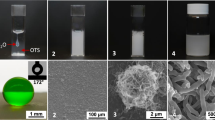Abstract
We describe a method to form hydrophobic surfaces using PHBV (Poly (hydroxybutyrate-co-hydroxyvalerate))—a kind of intrinsically hydrophilic material. The concentration of polymer solutions was varied to control the surface morphology and resultant wetting property. The as-prepared films were characterized by micro-scale valley-and-hill structure, which was formed by aggregating of electrospun beads. The bead morphology changed from smooth to porous and popcorn-like with decreased concentrations. The shape of water droplet on these surfaces had contact angles ranging from 110.7 to 158.1°, with a maximum standard deviation of 2.5°. It was found that both the micro and nanostructure were important to create a superhydrophobic surface.
Similar content being viewed by others
References
L. LARRONADA AND R. S. JOHN MANLEY, J. Polym. Sci. Pol. Phys. 19 (1981) 909.
WEIWEI ZUO, HAO YU, MEIFANG ZHU and YANMO CHEN, Polym. Eng. Sci. 45 (2005) 704.
F. VOLLRATH and D. T. EDMONDS, Nature 340 (1989) 305.
W. BARTHLOTT and C. NEINHUIS, Planta 202 (1997) 1.
LIN FENG, YANLIN SONG, JIN ZHAI, BIQIAN LIU, JIAN XU, LEI JIANG and DAOBEN ZHU, Angew. Chem. Int. Ed. 115 (2003) 824.
S. HERMINGHAUS, Europhys. Lett. 52 (2000) 165.
LEI ZHAI, ROBERT E. COHEN and MICHAEL F. RUBNER, Nano Lett. 4 (2004) 1349.
LIU HUAN, FENG LIN, ZHAI JIN, JIANG LEI and ZHU DAOBEN, Langmuir 20 (2004) 5659.
JAU-YE SHIU, CHUN-WEN KUO and CHUNG-YUAN MOU, Chem. Mater. 16 (2004) 5619.
M. T. KHORASANI and H. MIRZADEH, J. Appl. Polym. Sci. 91 (2004) 2042.
MORINAGA and TSUTOMU, J. Sol-Gel. Sci. Techn. 19 (2000) 211.
LEI JIANG, YONG ZHAO, and JIN ZHAI, Angew. Chem. Int. Ed. 43 (2004) 4338.
KAZIM ACATAY, SIMSEK EREN, OW-YANG CLEVA and YUSUF Z. MENCELOGLU, ibid. 43 (2004) 5210.
R. V. N. KRISHNAPPA, K. DESAI and CHANGMO SUNG, J. Mater. Sci. 38 (2003) 2357.
A. B. D. CASSIE and S. BAXTER, T. Faraday. Soc. 40 (1944) 546.
Adamson, in “Physical Chemistry of Surfaces” (Wiley, London, 1990) p. 415.
Author information
Authors and Affiliations
Corresponding author
Rights and permissions
About this article
Cite this article
Zhu, M., Zuo, W., Yu, H. et al. Superhydrophobic surface directly created by electrospinning based on hydrophilic material. J Mater Sci 41, 3793–3797 (2006). https://doi.org/10.1007/s10853-005-5910-z
Received:
Accepted:
Published:
Issue Date:
DOI: https://doi.org/10.1007/s10853-005-5910-z




